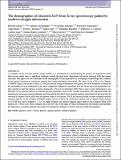Por favor, use este identificador para citar o enlazar a este item:
http://hdl.handle.net/10261/336069COMPARTIR / EXPORTAR:
 SHARE SHARE
 CORE
BASE CORE
BASE
|
|
| Visualizar otros formatos: MARC | Dublin Core | RDF | ORE | MODS | METS | DIDL | DATACITE | |

| Título: | The demographics of obscured AGN from X-ray spectroscopy guided by multiwavelength information |
Autor: | Laloux, Brivael; Georgakakis, Antonis; Andonie, Carolina; Alexander, David M.; Ruiz, Angel; Rosario, David J.; Aird, James; Buchner, Johannes; Carrera, Francisco J. CSIC ORCID CVN ; Lapi, Andrea; Ramos-Almeida, Cristina; Salvato, Mara; Shankar, Francesco | Palabras clave: | Galaxies: active X-rays: general Quasars: general Infrared: galaxies |
Fecha de publicación: | 2023 | Editor: | Oxford University Press | Citación: | Monthly Notices of the Royal Astronomical Society 518(2): 2546-2566 (2023) | Resumen: | A complete census of active galactic nuclei (AGNs) is a prerequisite for understanding the growth of supermassive black holes across cosmic time. A significant challenge towards this goal is the whereabouts of heavily obscured AGN that remain uncertain. This paper sets new constraints on the demographics of this population by developing a methodology that combines X-ray spectral information with priors derived from multiwavelength observations. We select X-ray AGN in the Chandra COSMOS Legacy survey and fit their 2.2−500μm spectral energy distributions with galaxy and AGN templates to determine the mid-infrared (6μm) luminosity of the AGN component. Empirical correlations between X-ray and 6μm luminosities are then adopted to infer the intrinsic accretion luminosity at X-rays for individual AGN. This is used as prior information in our Bayesian X-ray spectral analysis to estimate physical properties, such as line-of-sight obscuration. Our approach breaks the degeneracies between accretion luminosity and obscuration that affect X-ray spectral analysis, particularly for the most heavily obscured (Compton-Thick) AGN with low photon counts X-ray spectra. The X-ray spectral results are then combined with the selection function of the Chandra COSMOS Legacy survey to derive the AGN space density and a Compton-Thick fraction of 21.0+16.1−9.9 per cent at redshifts z < 0.5. At higher redshift, our analysis suggests upper limits to the Compton-Thick AGN fraction of ≲40 per cent. These estimates are at the low end of the range of values determined in the literature and underline the importance of multiwavelength approaches for tackling the challenge of heavily obscured AGN demographics. | Versión del editor: | https://doi.org/10.1093/mnras/stac3255 | URI: | http://hdl.handle.net/10261/336069 | DOI: | 10.1093/mnras/stac3255 | ISSN: | 0035-8711 |
| Aparece en las colecciones: | (IFCA) Artículos |
Ficheros en este ítem:
| Fichero | Descripción | Tamaño | Formato | |
|---|---|---|---|---|
| demographicsinformat.pdf | 2,87 MB | Adobe PDF |  Visualizar/Abrir |
CORE Recommender
SCOPUSTM
Citations
6
checked on 29-abr-2024
WEB OF SCIENCETM
Citations
5
checked on 25-feb-2024
Page view(s)
29
checked on 02-may-2024
Download(s)
7
checked on 02-may-2024
Google ScholarTM
Check
Altmetric
Altmetric
Este item está licenciado bajo una Licencia Creative Commons

